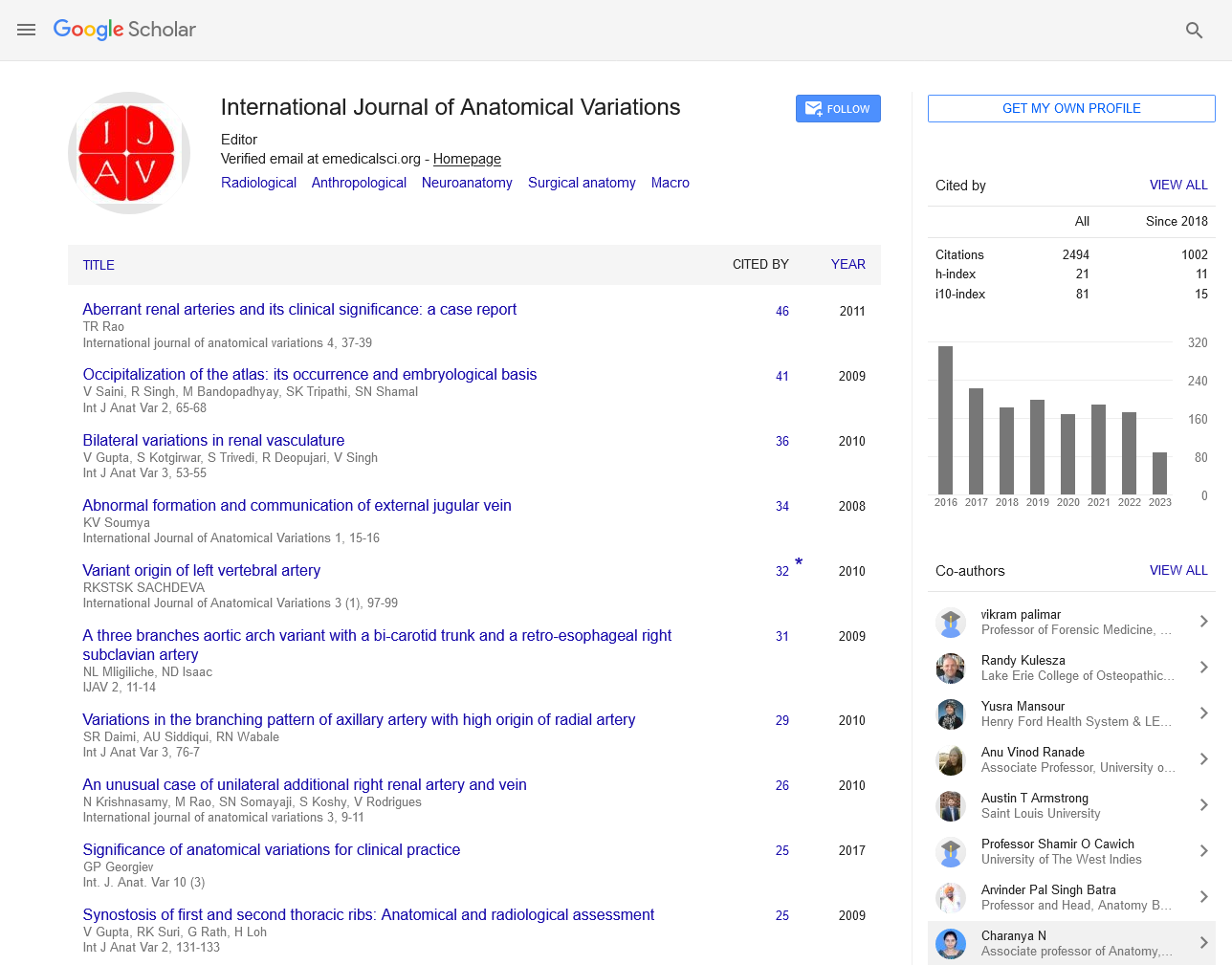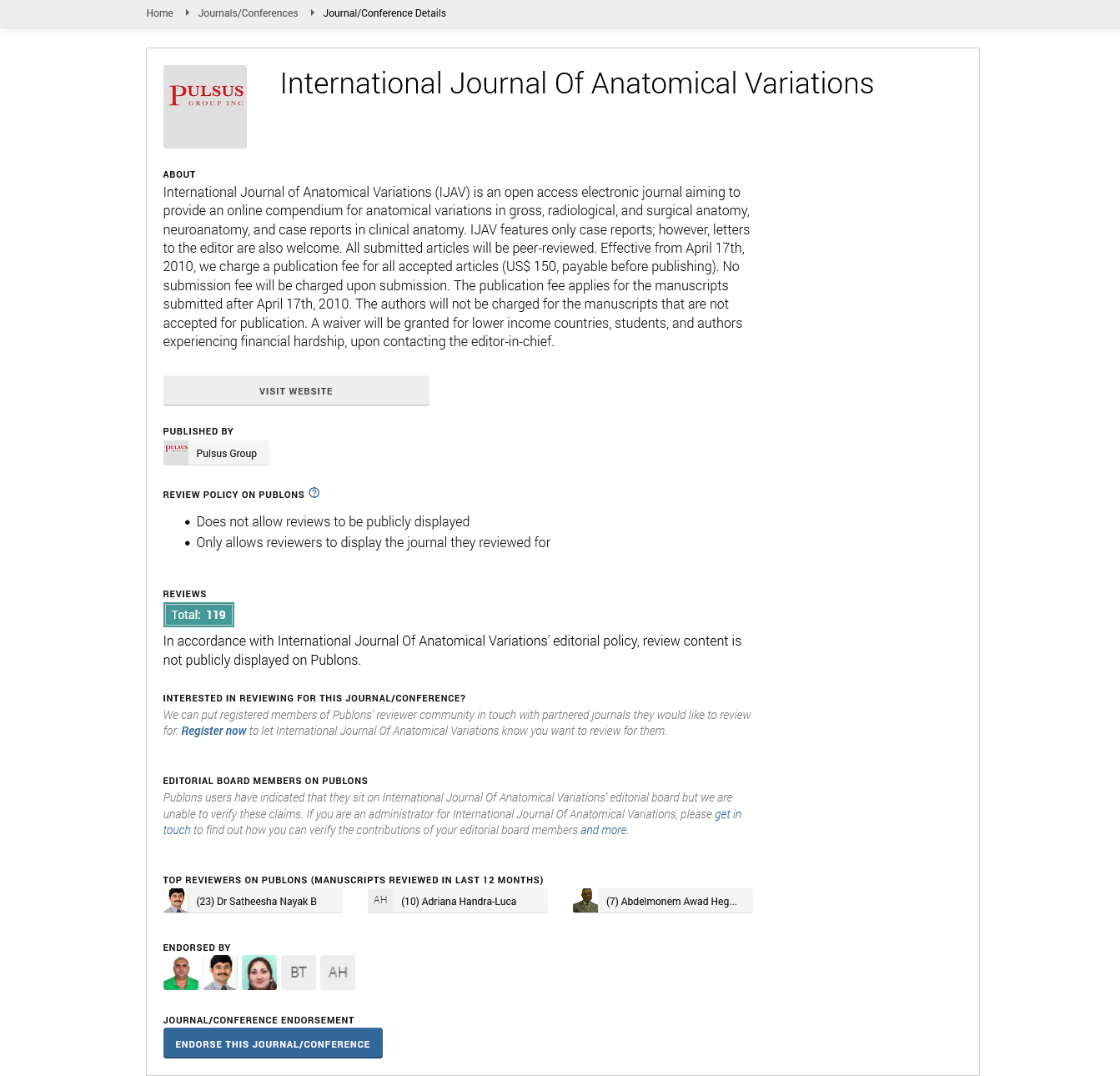Comparative Anatomy A Window into Evolutionary Biology and Functional Morphology
Received: 01-Mar-2025, Manuscript No. ijav-25-7640; Editor assigned: 04-Mar-2025, Pre QC No. ijav-25-7640 (PQ); Reviewed: 19-Mar-2025 QC No. ijav-25-7640; Revised: 26-Mar-2025, Manuscript No. ijav-25-7640 (R); Published: 30-Mar-2025, DOI: 10.37532/1308 4038.18(3).498
Citation: Singh A. Comparative Anatomy A Window into Evolutionary Biology and Functional Morphology. Int J Anat Var. 2025; 18(3): 765-766.
This open-access article is distributed under the terms of the Creative Commons Attribution Non-Commercial License (CC BY-NC) (http://creativecommons.org/licenses/by-nc/4.0/), which permits reuse, distribution and reproduction of the article, provided that the original work is properly cited and the reuse is restricted to noncommercial purposes. For commercial reuse, contact reprints@pulsus.com
Abstract
Comparative anatomy is a foundational discipline in biological sciences that examines the similarities and differences in the anatomical structures of organisms. This field provides critical insights into evolutionary relationships, developmental biology, and functional morphology. Through a comparative lens, anatomists can trace homologous structures across species, assess adaptations, and reconstruct evolutionary lineages. This paper explores the historical background, major methodologies, and contemporary applications of comparative anatomy, while also addressing its intersection with modern technologies like genomics and imaging techniques.
INTRODUCTION
Comparative anatomy has long served as a cornerstone of biological understanding, dating back to classical naturalists and early evolutionary theorists [1]. By comparing anatomical structures across taxa, scientists have gained insights into how life has evolved and diversified on Earth. Today, comparative anatomy remains integral to evolutionary biology, developmental biology, and palaeontology [2], offering a rich framework for interpreting both form and function in living and extinct organisms.
HISTORICAL CONTEXT
The study of comparative anatomy has deep historical roots, beginning with ancient scholars such as Aristotle, who made detailed anatomical observations of animals [3]. In the Renaissance, anatomists like Andreas Vesalius revived systematic human anatomical study, which later informed comparisons with other species. The field gained scientific rigor in the 18th and 19th centuries through the work of Georges Cuvier, who pioneered the principle of the "correlation of parts," and Richard Owen, who coined the term "homology" and distinguished it from analogy. Charles Darwin's theory of evolution by natural selection gave comparative anatomy a powerful explanatory framework, turning structural similarities into evidence of common descent [4].
HOMOLOGY AND ANALOGY
Homologous structures arise from a common ancestral origin, even if their functions differ (e.g., the forelimbs of humans, whales, and bats). Analogous structures, by contrast, perform similar functions but do not share a common ancestral origin (e.g., wings of birds and insects). Identifying homologies is crucial for reconstructing phylogenies [5].
MORPHOLOGICAL DIVERGENCE AND CONVERGENCE
Divergent evolution refers to the process by which related organisms evolve different traits, often due to different environmental pressures. Convergent evolution results in unrelated organisms developing similar traits independently due to similar ecological niches.
VESTIGIAL STRUCTURES
Structures that have lost most or all of their ancestral function (e.g., human appendix, pelvic bones in whales) offer clues about evolutionary history and previous lifestyles of organisms.
METHODOLOGIES IN COMPARATIVE ANATOMY
Traditional methods involve physical dissection and measurement of anatomical features. Morphometrics—the quantitative analysis of form—has evolved with digital imaging and statistical tools to enable detailed comparisons. Microscopic analysis of tissues provides insights into structural variations that are not visible to the naked eye. Histology bridges comparative anatomy with cellular biology. Modern imaging technologies such as MRI, CT scans, and 3D reconstructions enable non-invasive exploration of anatomy, enhancing studies of rare or fragile specimens. Comparative anatomical data are now often incorporated into cladistic analyses to generate evolutionary trees (cladograms), which visualize hypotheses about evolutionary relationships.
EVOLUTIONARY BIOLOGY
Comparative anatomy is central to testing evolutionary hypotheses, such as the transition from aquatic to terrestrial life or the evolution of flight.
FUNCTIONAL MORPHOLOGY
Understanding how anatomical features contribute to an organism’s performance in its environment—such as limb mechanics or jaw function—links form to function.
PALEONTOLOGY AND FOSSIL INTERPRETATION
Anatomical comparisons allow paleontologists to reconstruct the life habits of extinct species and understand their placement in the evolutionary tree.
DEVELOPMENTAL BIOLOGY
Embryological studies reveal how anatomical structures form and diverge, with shared developmental pathways supporting homology hypotheses.
MEDICINE AND VETERINARY SCIENCE
Insights from comparative anatomy inform surgical techniques, organ transplants, and understanding of congenital anomalies.
THE TETRAPOD LIMB
One of the most studied examples, the tetrapod limb shows remarkable homology across amphibians, reptiles, birds, and mammals, supporting the theory of common descent from lobe-finned fish ancestors.
BIRD AND DINOSAUR CONNECTION
Comparative studies of skeletal features and respiratory systems provide strong evidence that birds evolved from theropod dinosaurs.
HUMAN AND PRIMATE ANATOMY
Comparative analysis between humans and other primates, especially chimpanzees, reveals subtle differences in skeletal and muscular structures that explain unique human traits like bipedalism.
CHALLENGES AND FUTURE DIRECTIONS
Despite its successes, comparative anatomy faces challenges in resolving deep evolutionary relationships due to convergent evolution and incomplete fossil records. Future integration with molecular data (e.g., Evo-Devo approaches) and machine learning in morphometrics promises to refine our understanding of anatomical evolution.
REFERENCES
- Rayt HS, Bown MJ, Lambert KV. Buttock claudication and erectile dysfunction after internal iliac artery embolization in patients prior to endovascular aortic aneurysm repair. Cardiovasc Intervent Radiol. 2008; 31(4):728-34.
- Nayak SB, Shetty P, Surendran S, Shetty SD. Duplication of Inferior Gluteal Artery and Course of Superior Gluteal Artery Through the Lumbosacral Trunk. OJHAS. 2017; 16.
- Osher M, Semaan D, Osher D. The uterine arteries, anatomic variation and the implications pertaining to uterine artery embolization. J Vasc Interv Radiol 2014; 25:S143.
- Albulescu D, Constantin C, Constantin C. Uterine artery emerging variants - angiographic aspects. Current Health Sciences Journal 2014; 40:214-216.
- Patel SD, Perera A, Law N, Mandumula S. A novel approach to the management of a ruptured Type II endoleak following endovascular repair of an internal iliac artery aneurysm. Br J Radiol. 2011; 84(1008):e240-2.
Indexed at, Google Scholar, Crossref
Indexed at, Google Scholar, Crossref
Indexed at, Google Scholar, Crossref






